|
|
|
Sort Order |
|
|
|
Items / Page
|
|
|
|
|
|
|
| Srl | Item |
| 1 |
ID:
110149
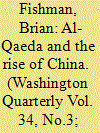

|
|
|
| 2 |
ID:
128315
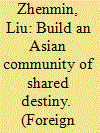

|
|
|
|
|
| Publication |
2013.
|
| Summary/Abstract |
As a member of Asia, China's development is rooted in Asia, and Asia has always been a priority on China's diplomatic agenda. China's growth has benefited from a peaceful neighboring area and, in turn, promoted stability and prosperity in Asia. At the same time, China and its neighbors are faced with both historic opportunities and challenges in development. Since the new government in China took office in 2013, China and other Asian countries have had frequent high-level exchanges and stronger cooperation in the field of economy and trade. China actively upholds peace and stability in the region and is working with other Asian countries to build a bright future for an Asian community of shared destiny.
|
|
|
|
|
|
|
|
|
|
|
|
|
|
|
|
| 3 |
ID:
159254
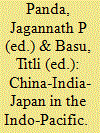

|
|
|
|
|
| Publication |
New Delhi, Pentagon, 2018.
|
| Description |
xviii, 398p.hbk
|
| Standard Number |
9789386618429
|
|
|
|
|
|
|
|
|
|
|
|
Copies: C:2/I:0,R:0,Q:0
Circulation
| Accession# | Call# | Current Location | Status | Policy | Location |
| 059404 | 320.12/PAN 059404 | Main | On Shelf | General | |
| 059405 | 320.12/PAN 059405 | Main | On Shelf | General | |
|
|
|
|
| 4 |
ID:
106560
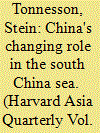

|
|
|
| 5 |
ID:
129851


|
|
|
|
|
| Publication |
2014.
|
| Summary/Abstract |
This article seeks to place recent developments in China in a larger context through three arguments. First, Chinese military policy has indeed made a major turning over the past decade; second, this turning is based on a fragile and unrealistic strategy that is already eliciting counterreactions that will make achievement of its apparent goals increasingly difficult. Finally, this strategy's failure will present China with unwelcome choices about how far to take her use of force. The "rise" of China is now encountering turbulence that may undo it.
|
|
|
|
|
|
|
|
|
|
|
|
|
|
|
|
| 6 |
ID:
152426


|
|
|
|
|
| Summary/Abstract |
China is one of the most signifi cant players in the South China Sea and its activities, policies and strategies have always had a deep impact on the Asia–Pacifi c region. Leishangthem Bimolchand Singh analyses China’s position and assertive moves over the issue as well as its response to the recent arbitral tribunal’s ruling on the South China Sea.
|
|
|
|
|
|
|
|
|
|
|
|
|
|
|
|
| 7 |
ID:
120552
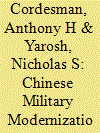

|
|
|
|
|
| Publication |
Washington DC, Center for Strategic & International Studies, 2012.
|
| Description |
226p.Hbk
|
| Contents |
B
|
|
|
|
|
|
|
|
|
|
|
|
Copies: C:1/I:0,R:0,Q:0
Circulation
| Accession# | Call# | Current Location | Status | Policy | Location |
| 057303 | 355.60951/COR 057303 | Main | On Shelf | General | |
|
|
|
|
| 8 |
ID:
108560


|
|
|
| 9 |
ID:
127417
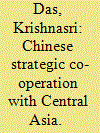

|
|
|
| 10 |
ID:
157964
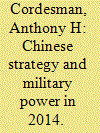

|
|
|
|
|
| Publication |
Lanham, Rowman and Littlefield, 2014.
|
| Description |
xi, 515p.: tablespbk
|
| Standard Number |
9781442240391
|
|
|
|
|
|
|
|
|
|
|
|
Copies: C:1/I:0,R:1,Q:0
Circulation
| Accession# | Call# | Current Location | Status | Policy | Location |
| 059333 | 355.033551/COR 059333 | Main | On Shelf | Reference books | |
|
|
|
|
| 11 |
ID:
155018
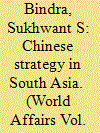

|
|
|
|
|
| Summary/Abstract |
Sukhwant S Bindra traces the changes in Chinese diplomacy over the past few decades, with special reference to India, Pakistan, other South Asian countries and Russia. He points out that the Sino–Pak alliance has grown out of converging interests, although Beijing is wary of Pakistan’s internal instability and support of Islamic radicalism in Asia. He concludes that India has no choice but to simultaneously collaborate with and stand up to China.
|
|
|
|
|
|
|
|
|
|
|
|
|
|
|
|
| 12 |
ID:
156060


|
|
|
|
|
| Summary/Abstract |
Sukhwant S Bindra traces the changes in Chinese diplomacy over the past few decades, with special reference to India, Pakistan, other South Asian countries and Russia. He points out that the Sino–Pak alliance has grown out of converging interests, although Beijing is wary of Pakistan’s internal instability and support of Islamic radicalism in Asia. He concludes that India has no choice but to simultaneously collaborate with and stand up to China.
|
|
|
|
|
|
|
|
|
|
|
|
|
|
|
|
| 13 |
ID:
127575
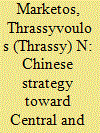

|
|
|
|
|
| Publication |
2012.
|
| Summary/Abstract |
As China's economy has grown and become integrated into the global market, both have become interdependent. Therefore China's long-term development goals will only be possible with increasing and stable access to foreign trade, resources, and energy. The latter has become a pressing issue as the country's dependence on international energy imports rapidly increases and might impose a limit on its growth if left unmet. This is especially important given supply shortages as a result of the recent events in Libya and given the future prospect of supply disruptions from the Middle East. In the case of oil, the International Energy Agency (IEA) forecast in 2010 that Chinese imports would grow from 4.3 million barrels a day (m/bd) in 2009 to 12.8 m/bd in 2035, thus rising from 53% to 84% of the total demand. The issue of resource shortages will play an even more prominent role in international relations and will become an increasing source of conflict among major powers. Given the fact that some countries are more generously endowed with strategic resources, this opens up the possibility of using these tools for political gain. Historically, economic diplomacy has contributed to the shifting balance of power in the world. Nations have more often been inclined to employ economic measures in pursuit of foreign policy objectives when "the legitimacy of the power of existing structures of international cooperation decreases." The result of the current realignment of geo-economic power will encourage nations to reassess the effectiveness of their energy, economic, and foreign policies.
|
|
|
|
|
|
|
|
|
|
|
|
|
|
|
|
| 14 |
ID:
126147
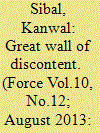

|
|
|
|
|
| Publication |
2013.
|
| Summary/Abstract |
Our relationship with China in the last decade shows features of tensions, mistrust and lack of a solution to some underlying problems coupled with efforts to build confidence, engagement and progress in some areas. In other words, the quality of the relationship has remained largely unchanged. Ties today would be probably a shade worse than they were a decade ago.
|
|
|
|
|
|
|
|
|
|
|
|
|
|
|
|
| 15 |
ID:
175653


|
|
|
|
|
| Summary/Abstract |
Wedging is an important strategy for China to disrupt potential countervailing response in its quest for regional hegemony. Yet, little has been known about how China pursues this strategy and the conditions for its success. This article contends that China has employed a combined statist and trans-state approach to wedge the U.S.-Australia alliance. Beijing has two main aims: promote an alignment of interest with Canberra at Washington’s expense and prevent Canberra from siding with Washington. It relies on three modes of influence (coercion, inducement and persuasion) to alter the costs and benefits of Canberra remaining aligned to Washington. The success of China’s wedge strategy is contingent on the use of policy compartmentalisation, the target’s regime type and the nature of its trans-state influence. China has achieved partial success in three issue areas: the South China Sea dispute, the U.S.-China 5G competition and the international isolation of Taiwan.
|
|
|
|
|
|
|
|
|
|
|
|
|
|
|
|
| 16 |
ID:
145406
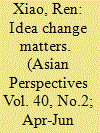

|
|
|
|
|
| Summary/Abstract |
In this article I examine the changes in China's foreign policy thinking and how they have influenced China's international behavior. I reveal how the leadership's beliefs guided and drove the Chinese state's behavior. When leaders believed that the world was in a “war and revolution” age, China was inclined to overlook the actual international order and institutions and backed revolutionary movements or armed struggles in other countries. The cognitive shift to “peace and development” in the 1980s, which was consolidated in the 1990s through two major debates, was fundamental in terms of strategically reshaping China's behavior, turning it from a revolutionary state into a quasi–status quo state. Besides embracing international institutions, China has also joined neighboring countries in creating new regional institutions and norms in East Asia. I argue that ideas, and not only perceptions, guide China's policymaking and international behavior.
|
|
|
|
|
|
|
|
|
|
|
|
|
|
|
|
| 17 |
ID:
109726
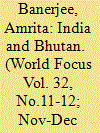

|
|
|
| 18 |
ID:
118743


|
|
|
|
|
| Publication |
2012.
|
| Summary/Abstract |
Everyone knows that in addition to its keen interest in the Southern and Northern Caucasus, the People's Republic of China (PRC) is also active in Central Asia, another area of its geopolitical interests.
Much has and is being written about this, but for some reason no one has examined China's presence in the Northern Caspian (I have in mind the Atyrau Region of Kazakhstan, the relations with which are part and parcel of China's Central Asian policy, and the Astrakhan Region and Kalmykia of Russia).
Here I will dwell on Chinese strategy in the two latter regions of the Russian Federation, that is, in the Russian part of the Northern Caspian. As a sort of corridor or link between Central Asia and the Caucasus with a multitude of ties between them and this part of Russia, the region is of immense geopolitical importance for Beijing.
|
|
|
|
|
|
|
|
|
|
|
|
|
|
|
|
| 19 |
ID:
156880
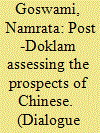

|
|
|
| 20 |
ID:
141913
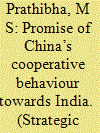

|
|
|
|
|
| Summary/Abstract |
India’s economic rise in the last decade has prompted China to seek greater cooperation with India. The Chinese strategy promises that India will profit from the wide-ranging economic engagement and importantly blunts any perceived support to the US in the containment of China. Clearly, for China, any ‘rebalancing’ in the Asia Pacific is upsetting and therefore India’s strategic partnerships with the United States, Japan or Vietnam are keenly observed. As a result, there is intense Chinese pressure on India to cooperate on its terms, for example China’s One Road One Belt project. China also believes that it is in an advantageous economic and military position vis-à-vis India and therefore any perceived aggression from the Indian side, such as overt strategic engagements with the US, quickly prompts China to create sub-level crises so as to weaken India’s claims to the border or create uncertainty in the minds of the leadership.
|
|
|
|
|
|
|
|
|
|
|
|
|
|
|
|
|
|
|
|
|